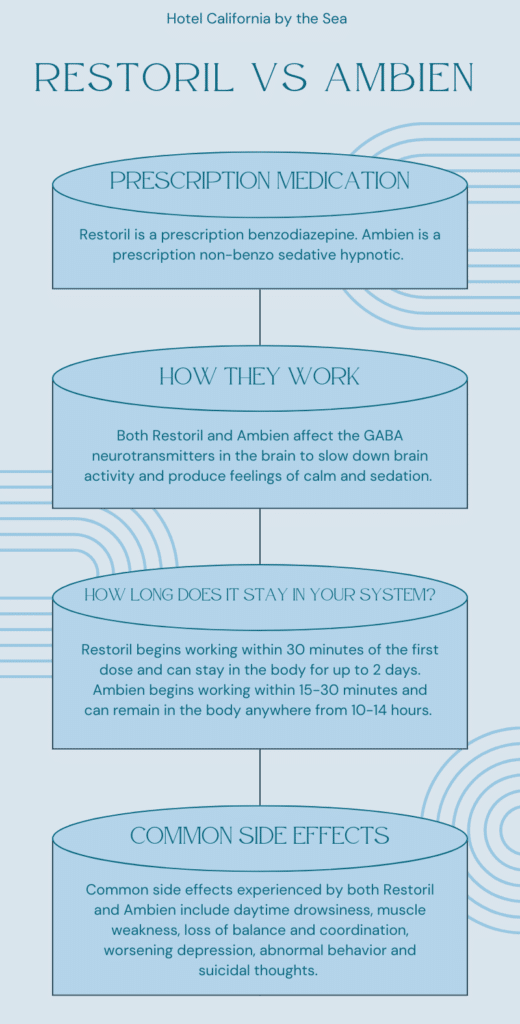Restoril vs Ambien
Restoril vs Ambien, which medication works best for treating anxiety and depression? Anxiety, depression and insomnia are some of the most common conditions disrupting mental health for many people across the US. The evidenced proven treatments for co-occurring mental health conditions include both medication and intensive therapy treatments. Two of the most commonly prescribed medications for treating sleep conditions include Restoril, the brand name of temazepam and Ambien the brand name of zolpidem.
Restoril and Ambien treat insomnia and other sleep disorders often created by mental health conditions. Both medications work by slowing down brain activity, allowing the body and brain to relax and induce a sense of calm and relaxation to help users sleep. They are both DEA schedule IV Controlled Substances which are usually available in pill form. Common side effects between the two medications include:
- Dizziness
- Daytime drowsiness
- Muscle weakness
- Loss of balance or coordination
- Headache
- Blurred vision
- Nausea and dry mouth
Despite treating the same conditions, these prescription medications have different effects and perform differently. Restoril is a class of drugs called benzodiazepines. While the Ambien medication is a type A GABA receptor agonist.

What is Restoril?
Restoril is an intermediate-acting 3-hydroxy hypnotic benzo. It is often prescribed to treat symptoms of insomnia and other sleep-related disorders. Temazepam was first synthesized in 1964.
By the 1980s, the substance had become a widely prescribed hypnotic medication to treat insomnia. Like many other benzos, the development of tolerance and dependence can lead to addiction and cause withdrawal symptoms once usage has stopped.
Because of the high risks for substance dependence, Restoril is primarily recommended for short-term use ranging from 7-10 days. Restoril has a half-life of around 16 hours. Benzos also have a long history associated with drug abuse and addiction.
From 2015-2016, an estimated half a million Americans had a benzo use disorder. In 2016, benzo-related ER visits outnumbered opioid-related ER visits. According to the U.S. Poison Control Center, in 2017, about 63% of benzo overdoses also involved other drugs such as opioids, alcohol, and stimulants.
In 2018 an estimated 5.4 million people ages 12 and older in the United States abused benzos. According to data from the CDC, an estimated 30% of pharmaceutical overdoses have been linked to benzos such as Restoril.
Common side effects of Restoril include:
- Fatigue
- Nervousness
- Tiredness and drowsiness
- Dizziness
- Nausea
- Headache
- Excitability
- Irritability
- Increased feelings of thirst
- Numbness
- Burning pain
Side effects of dependence, addiction and overdose include:
- Intense sedation
- Slurred speech
- Difficulty breathing
- Seizures
- Impaired memory
- Risk of withdrawal
- Complex behaviors and doing things while not completely conscious such as eating, driving, talking or sleeping
- Suicide behavior and thoughts
- Abnormal thoughts
- Aggression
- Hallucinations
- Confusion
- Worsening depression
Restoril is a short-acting benzo that can take effect quickly and leave the body quickly after ingestion. Once a person has become dependent and addicted to the substance, more of the drug is needed. The absence of Restoril can begin to deny the brain of dopamine surges and an abundance of GABA receptors. This leads to feelings of depression, anxiety and withdrawal symptoms.

What is Ambien? Is Ambien a Controlled Substance?
Ambien is a sedative-hypnotic that can affect the central nervous system. It is prescribed to treat insomnia on a short-term treatment basis. It is a popular sleeping pill that can begin taking effect as quickly as 15-30 minutes and contains a half-life of about 2.5 hours.
According to the National Survey on Drug Use and Health, more than half a million people in the United States abuse Ambien and other sedative prescription medications. Between 2006 and 2011, an estimated 38 million prescriptions for zolpidem drugs were written, according to IMS Health. Ambien’s increase in accessibility and availability has allowed more people to be exposed to a greater risk of Ambien dependence and addiction.
Is Ambien a controlled substance? Ambien is a Schedule IV controlled substance. It has a potential for abuse and addiction.
Like other central nervous system depressants, Ambien can cause risks for intense sedation, respiratory depression and coma. Other common side effects include:
- Nasal irritation
- Sore throat
- Constipation
- Diarrhea
- Mental Confusion
- Loss of muscle control and coordination
- Euphoria
- Rebound insomnia
- Abnormal sleep behaviors and sleep problems such as sleepwalking, sleep talking and sleep driving
- Daytime sleepiness
- Abnormal thoughts including suicidal thoughts
- Worsening depression
- Liver damage
- Risk for withdrawal symptoms
- Amnesia
- Extreme mood swings
Signs you may be addicted to Ambien
- You are refilling prescriptions often
- You repeatedly taking larger doses of medication than prescribed
- You have cravings for the medication
- You engage in dangerous situations while under the influence of medication
- You spend large amounts of money on obtaining the drug
- You isolate yourself from friends and family in favor of drug use
Check Your Insurance Coverage for FREE
Find out if your insurance covers addiction treatment in minutes. We accept most insurance!
Restoril vs Ambien
Both Restoril and Ambien are sleeping aids used to treat symptoms of insomnia and various sleep conditions. Both are recommended for short-term use and have the potential for addiction. The risk becomes even greater when combined with other substances such as opioids, alcohol, stimulants and depressants. Polydrug use can lead to life threatening side effects such as sedation, respiratory depression, confusion and coma.
Restoril
- Generic name: Temazepam
- Prescription benzodiazepine
- Controlled IV substance with high risk of abuse and addiction
- GABA neurotransmitters are made in the brain and when there is a low amount of GABA receptors, people can experience symptoms of stress, anxiety, insomnia and depression. Restoril works by increasing the GABA neurotransmitter, which helps to slow down brain activity, causing drowsiness and calming effects
- Starts working within 30 minutes after first dose and can stay in your systems for up to 2 days
- Addiction to Restoril can cause an increase in worsening depression as well as the development of abnormal thoughts and behaviors
- Restoril dependence can also increase the risk of suicidal thinking and behaviors within the first few months of treatment
- Risk of developing a tolerance to Restoril can occur within 3 days of use. This makes the user feel like they need to use more in order to feel the desired effects
Ambien
- Generic name: Zolpidem
- Prescription non-benzo sedative-hypnotic
- Controlled IV substance with high risk of abuse and addiction
- Ambien works by activating the GABA neurotransmitter to slow down brain activity making the users feel more calm and relaxed
- Starts working within 15-30 minutes and can stay in your system for up to 10-14 hours
- Ambien is meant to be taken right before bed in order to help the brain and body relax and fall asleep
- Ambien addiction can lead to worsening symptoms of insomnia often referred to as rebound insomnia
- Ambien-induced hallucinations can also occur and are more likely to happen with polydrug use when a user is mixing Ambien with other drugs. Leading to a potential risk for psychosis.
- Physical dependence on Ambien can begin within 2 weeks of use and is characterized by impaired control over use, compulsive use and symptoms of withdrawal when usage has been significantly reduced or stopped
Reach out to Hotel California by the Sea
We specialize in treating addiction and other co-occurring disorders, such as PTSD. Our Admissions specialists are available to walk you through the best options for treating your addiction.
At Hotel California by the Sea, the prescription drug abuse treatment program provides the tools and resources clients need to overcome their addiction to drugs. Popular benzo medications such as Restoril have led to difficult addictions that require professional help. Behavioral health treatment programs include detox, residential, PHP and IOP programs meant to treat every aspect of a person’s addiction.
Throughout each level of care, evidence-based treatments such as MAT, CBT, DBT and EMDR therapy have proven successful in addiction healing. Hotel California by the Sea understands there is no one-size-fits-all when it comes to addiction treatment. Clients will receive individualized care and support throughout their recovery journey.
References:
https://www.goodrx.com/compare/restoril-vs-ambien
https://addictionresource.com/drugs/restoril/restoril-and-ambien/
https://www.rxlist.com/restoril_vs_ambien/drugs-condition.htm
https://medlineplus.gov/druginfo/meds/a684003.html
https://www.goodrx.com/temazepam/what-is
https://www.healthline.com/health/drugs/temazepam-oral-capsule
